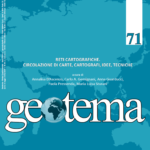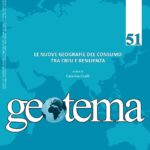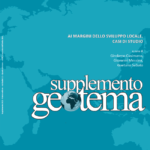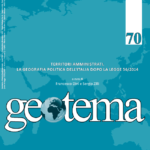Carlo Alberto Gemignani
Dalla foto alla mappa: innovazioni tecnico-scientifiche, continuità e rivoluzioni visive nel secondo Ottocento. Spunti preliminari
Il presente lavoro nasce dal desiderio di analizzare il legame tra fotografia e cartografia nel suo valore storico. Il punto di partenza è dato dalla lettura di un rapporto presentato all’Académie des sciences di Parigi nel 1860, riguardante l’analisi critica del metodo fototopografico elaborato dal capitano degli ingegneri militari francesi Aimé Laussedat (1819-1907). La volontà di Laussedat di trasformare la fotografia in mappa deve essere compresa a partire dai cambiamenti tecnologici in atto e inscritta nella più generale rivoluzione visiva avvenuta tra il XIX e il XX secolo. In questi anni, infatti, si verificano cambiamenti significativi nelle modalità attraverso le quali si struttura la visione geografica della realtà nel mondo occidentale. Questo lavoro cerca di offrire alcune idee per future indagini. La pratica «borghese» della fotografia paesaggistica «turistica» e quella incarnata dalla fototopografia militare possono infatti essere intese come aspetti diversi ma interconnessi di appropriazione dello spazio geografico, entrambe collegate a una fase di affermazione del capitalismo moderno e delle sue diverse modalità di territorializzazione. Siamo in presenza di due visioni normative: quella più tecnica, orientata alla sorveglianza armata del territorio, e quella che prelude alla sua commercializzazione, attraverso la spettacolarizzazione del paesaggio.
Abstract: From Photo to Map: Scientific and Technological Innovations, Continuities and Visual Revolutions in the Second Half of the Nineteenth Century. Preliminary Ideas
The present work originates from the need to analyse the relationship between photography and cartography in its historical value. The starting point is the review of a report presented to the Académie des sciences in Paris in 1860, concerning the critical analysis of the photo-topographic method elaborated by the captain of the French military Engineers Aimé Laussedat (1819-1907). Laussedat’s will to transform photography into a map should be inscribed in its links with technological changes in progress and in the more general visual transformation occurred between the nineteenth and twentieth centuries. In fact, in these years significant changes have taken place in the Western geographical vision of reality which have come down to us. This work tries to offer some ideas for future investigations. The military photo-topography and the «bourgeois» practice of «touristic» landscape photography could be understood, indeed, as two different but intertwined aspects of appropriation of the geographical space, both connected with one of the phases of affirmation of modern capitalism and its different territorialisation modalities. Two normative visions: the most technical one, aimed at the armed surveillance of the territory, and the one that is a prelude to its commercialization, through the tend of spectacularizing the landscape.
Résumé: De la photographie au plan : innovations scientifiques et techniques, continuités et révolution visuelle. Premières pistes de réflexion
Ce travail découle du propos d’analyser le rapport entre photographie et cartographie en sa valeur historique. Le point de départ est donné par la lecture du rapport présenté à l’Académie française des sciences de Paris en 1860. Le rapport concernait l’analyse critique de la méthode photo-topographique élaborée par le capitaine des ingénieurs militaires français Aimé Laussedat (1819-1907). On peut comprendre l’intention de Laussedat de transformer la photo en carte en considérant, d’abord, les changements des techniques en cours : une intention qui s’inscrit dans le cadre plus général de la révolution visuelle qui s’est produite entre XIXe et XX siècles. Les innovations sur la manière de structurer la vision géographique du réel dans les sociétés occidentales sont, pendant la période considérée, très importantes. L’article essaie d’offrir quelques repères pour des éventuelles recherches à venir. La pratique « bourgeoise » de la photographie « touristique » du paysage et la pratique de la
photo topographie militaire peuvent être considérées en tant que formes tout à fait différentes. Cependant, photo et carte sont liées au processus d’appropriation de l’espace géographique, c’est-à-dire au tournant d’affirmation du capitalisme moderne et à ses formes de territorialisation. On est devant deux paradigmes normatifs : celui plus technique, orienté à la surveillance armée du territoire, et celui qui prélude à sa commercialisation par la représentation spectaculaire du paysage.
Parole chiave: fotografia, cartografia, storia della geografia, storia delle rivoluzioni visive, fotogrammetria
Keywords: photography, cartography, history of geography, history of visual revolutions, photogrammetry
Mots-clés: photographie, cartographie, histoire de la géographie, histoire de la révolution visuelle, photogrammétrie









